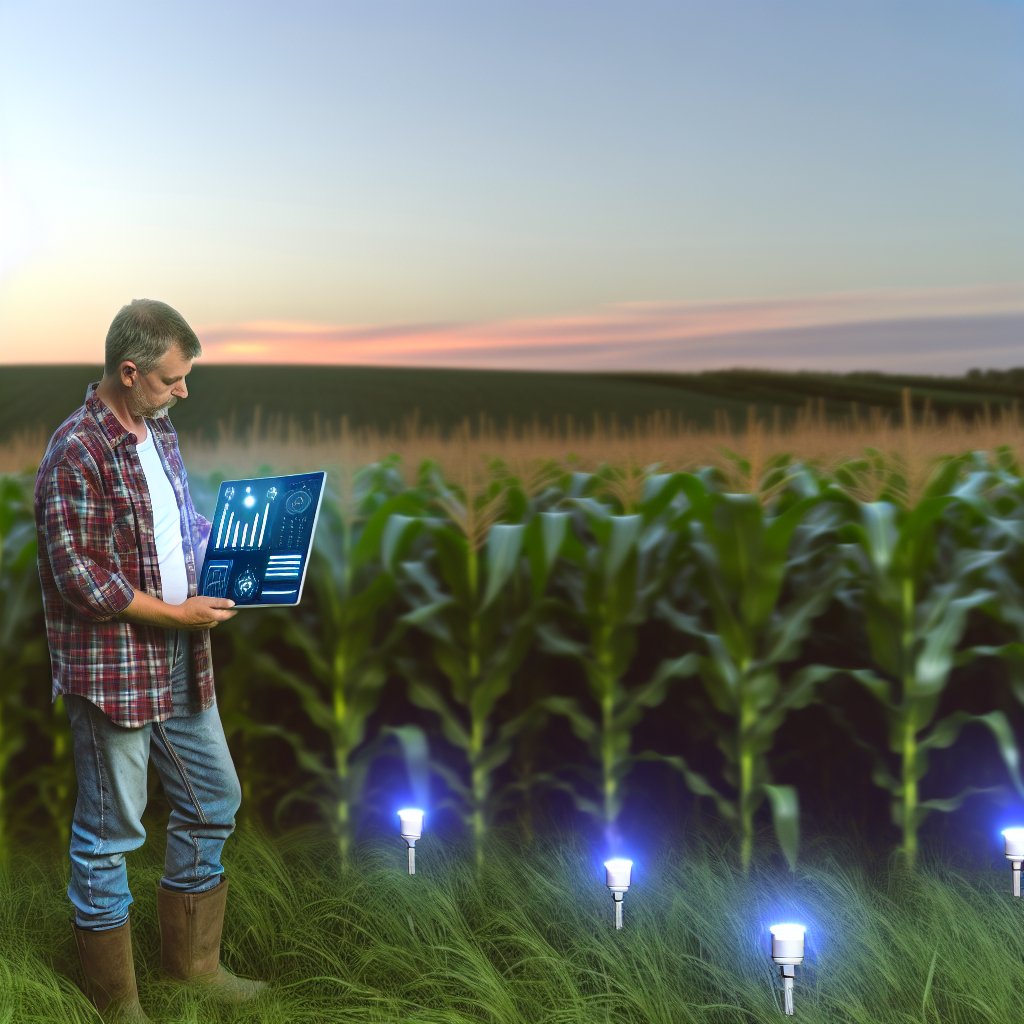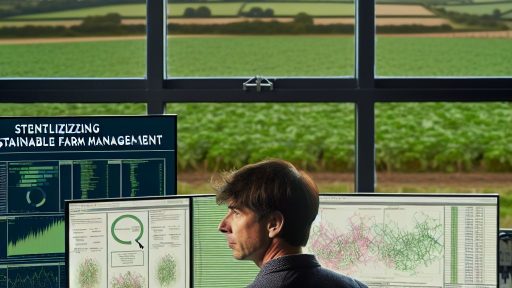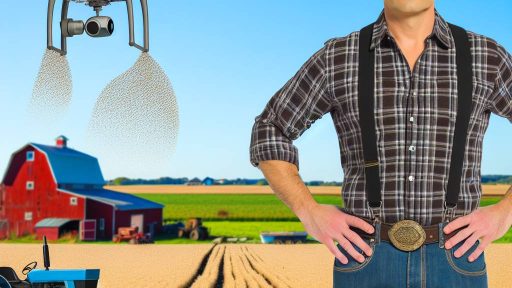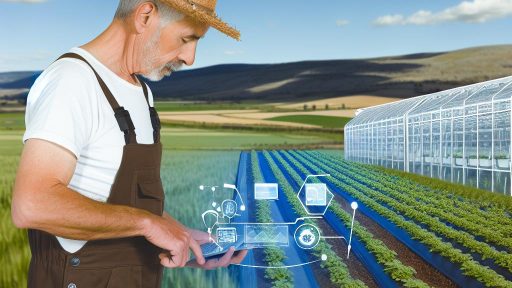Introduction to IoT in Agriculture
Definition of IoT
The Internet of Things (IoT) refers to interconnected devices that communicate over the internet.
This technology enables real-time data collection and sharing.
In agriculture, IoT devices include sensors, drones, and machines.
These devices gather critical information on various farm parameters.
Importance of IoT in Agriculture
IoT technologies significantly enhance farm operations.
They help farmers monitor weather conditions accurately.
Moreover, they enable precise irrigation management.
Farmers can optimize resource use through data analysis.
As a result, crop yields often increase while costs decrease.
Key Benefits of IoT Technologies
IOT technologies bring several advantages to modern farming.
- Improved efficiency through automation and data insights.
- Enhanced decision-making based on real-time data.
- Reduced operational costs through resource optimization.
- Increased productivity and crop health monitoring.
Farmers experience a transformation in operational capabilities.
Challenges in Implementing IoT
Despite its benefits, IoT adoption faces challenges.
Technical issues often arise due to integration complexity.
Additionally, reliability of connectivity in rural areas can hinder progress.
Farmers may also struggle with data management.
Transform Your Agribusiness
Unlock your farm's potential with expert advice tailored to your needs. Get actionable steps that drive real results.
Get StartedData security presents another significant concern in IoT implementations.
Key IoT Technologies Utilized in Farming
Sensors in Agriculture
Sensors play a crucial role in modern farming.
They monitor soil moisture, temperature, and nutrient levels.
Moreover, these devices provide real-time data to farmers.
This information helps optimize irrigation practices.
In turn, it reduces water usage significantly.
Additionally, sensors can detect pests and diseases early.
Farmers can take action promptly, minimizing crop loss.
Using sensors contributes to enhanced productivity and sustainability.
Drones in Farming
Drones are revolutionizing agricultural practices.
They offer aerial views of farms for better management.
Drones can assess crop health using multispectral imaging.
This technology enables targeted treatments for specific areas.
Furthermore, drones assist in mapping field variability.
Farmers can use this data to apply inputs more efficiently.
As a result, crop yields increase while costs decrease.
Drones also enable quick monitoring of large land areas.
GPS Technology in Agriculture
GPS technology enhances precision farming techniques.
This system allows farmers to track the location of tractors.
It also helps in mapping fields accurately.
Farmers can create detailed maps for planting and harvesting.
This practice leads to improved resource management.
Additionally, GPS technology supports automated machinery.
Automated systems reduce labor costs and increase efficiency.
Showcase Your Farming Business
Publish your professional farming services profile on our blog for a one-time fee of $200 and reach a dedicated audience of farmers and agribusiness owners.
Publish Your ProfileOverall, GPS technology contributes to smarter farming operations.
Benefits of IoT Adoption in Farm Operations
Enhanced Productivity
IoT technologies significantly boost farm productivity.
They automate various processes on the farm.
This automation reduces human error and increases efficiency.
Furthermore, IoT devices provide real-time data analysis.
Farmers can make informed decisions quickly.
As a result, crop yields improve over time.
Improved Resource Management
IoT enhances resource management practices on farms.
With smart sensors, farmers can monitor soil conditions continuously.
This feature ensures proper irrigation and fertilization.
By optimizing these inputs, costs decrease significantly.
Additionally, IoT devices track livestock health more accurately.
This tracking helps in preventing disease outbreaks early.
Moreover, it maximizes animal productivity and welfare.
Efficient Supply Chain Management
The integration of IoT in supply chains offers remarkable efficiency.
Farmers can track product conditions during transportation.
This visibility helps maintain quality and minimize spoilage.
Consequently, profit margins increase due to reduced losses.
Furthermore, IoT facilitates better inventory management.
Farmers can monitor stock levels and predict demand more effectively.
Environmental Sustainability
Adopting IoT technologies promotes environmental sustainability.
Smart irrigation systems reduce water waste drastically.
Similarly, precise fertilization minimizes chemical usage.
These practices lead to healthier ecosystems and soil.
Moreover, farmers can monitor their carbon footprints easily.
This knowledge encourages practices that reduce environmental impact.
Explore Further: Implementing AI And Machine Learning In Crop Disease Detection Systems
Case Studies of Successful IoT Implementation in Agriculture
Introduction to IoT in Agriculture
IoT technologies have transformed modern agriculture practices.
These tools connect devices for improved data collection and analysis.
Many farms have reported increased efficiency and productivity.
Precision Farming with Smart Sensors
Agriculture Solutions Inc. implemented smart sensors on their fields.
These sensors monitor soil moisture levels in real time.
As a result, they optimized irrigation schedules effectively.
Farmers reduced water consumption by 30% using this technology.
Moreover, they noticed a significant increase in crop yield.
Livestock Monitoring and Management
Green Pastures Farm adopted IoT devices for livestock tracking.
These devices provide vital health and location data for each animal.
Consequently, the farm enhances its overall herd management.
They reduced livestock diseases through early detection.
This implementation increased overall production efficiency.
Showcase Your Farming Business
Publish your professional farming services profile on our blog for a one-time fee of $200 and reach a dedicated audience of farmers and agribusiness owners.
Publish Your ProfileClimate Monitoring Systems
HarvestTech introduced climate monitoring systems across their land.
These systems track temperature and humidity levels continuously.
Farmers quickly adapt to weather changes, improving planning.
As a result, crop losses due to adverse weather decreased significantly.
Furthermore, this data-driven approach enhanced decision-making.
Lessons Learned from Successful Implementations
Successful IoT implementations share common strategies.
First, engage stakeholders and train staff in using new technologies.
This training is crucial for maximizing the technology’s potential.
Also, invest in reliable network infrastructure to support IoT devices.
Lastly, analyze data regularly to make informed decisions.
Learn More: Cost-Effective Farm Management Software Options For Small Farms
Challenges and Barriers to IoT Adoption in Farming
Cost Considerations
The implementation of IoT in farming often requires significant financial investment.
Initial costs include purchasing devices, sensors, and infrastructure upgrades.
Farmers may struggle to justify these expenses, especially smallholders.
Additionally, ongoing maintenance costs can add a financial burden.
Despite potential long-term savings, the upfront investment remains daunting.
Technology Limitations
Adequate technology infrastructure is essential for effective IoT deployment.
In rural areas, internet connectivity can pose a major challenge.
Low bandwidth and unreliable connections hinder data transmission.
Farmers may also face challenges in selecting the right technology solutions.
Device compatibility and software integration can complicate the adoption process.
Training and Education Gaps
Understanding IoT technology requires a certain level of expertise.
Many farmers lack the technical skills needed to implement IoT systems.
Without proper training, they may struggle to operate new technologies effectively.
Furthermore, educational resources may not be readily available in rural communities.
Building comprehensive training programs is crucial for successful adoption.
Resistance to Change
Traditionally, farmers are accustomed to established practices and methods.
This mindset can lead to resistance against adopting new technologies.
Some may doubt the benefits IoT can bring to their operations.
It is vital to demonstrate clear advantages to encourage acceptance.
Generating success stories could help alleviate these concerns.
Delve into the Subject: The Future Of Farming Trends In Automated Machinery

Future Trends in IoT for Agriculture
Advancements in Sensor Technology
Innovative sensor technology is transforming agricultural practices.
These sensors monitor soil moisture, temperature, and nutrient levels.
They provide real-time data that enhances decision-making.
Farmers can optimize irrigation and fertilization schedules effectively.
As a result, they can improve crop yields significantly.
Integration of AI and Machine Learning
Artificial intelligence is paving the way for smarter farming.
Integrating AI with IoT allows for predictive analytics.
Farmers can anticipate pest outbreaks and crop diseases.
Showcase Your Farming Business
Publish your professional farming services profile on our blog for a one-time fee of $200 and reach a dedicated audience of farmers and agribusiness owners.
Publish Your ProfileThis proactive approach greatly reduces losses.
Moreover, machine learning algorithms continually improve system accuracy.
Drone Technology in Precision Agriculture
Drones are becoming essential tools in modern farming.
They allow for aerial mapping and monitoring of crops.
This technology provides insights into plant health and growth patterns.
Farmers can conduct targeted interventions where needed.
Ultimately, this results in more efficient resource use.
Blockchain for Supply Chain Transparency
Blockchain technology enhances agricultural supply chains.
It provides transparency from farm to consumer.
This technology ensures the traceability of products.
Farmers can verify the authenticity of their produce.
Consumers gain confidence in the food they purchase.
Smart Farming: An Integrated Approach
Smart farming integrates various IoT technologies seamlessly.
This approach creates a cohesive farming ecosystem.
Farmers can control irrigation, fertilization, and pest control remotely.
Data from multiple sources contributes to informed decisions.
Ultimately, this leads to sustainable farming practices.
See Related Content: Greenhouse Technologies Advancing Sustainable Agricultural Methods
Best Practices for Integrating IoT Solutions in Farm Management
Understanding IoT Technologies
IoT technologies offer numerous advantages for farming operations.
They enhance data collection and improve decision-making processes.
Farmers can utilize sensors, drones, and smart devices for efficiency.
Assessing Your Farm’s Needs
Begin by evaluating your farm’s specific requirements and challenges.
Identify areas where IoT can drive significant improvements.
Consider aspects such as crop monitoring, soil health, and resource management.
Choosing the Right IoT Solutions
Select IoT solutions that align with your farm’s objectives.
Research various devices and platforms available in the market.
Ensure they provide features that suit your operational needs.
Integrating IoT Technologies
Start integrating IoT devices through a phased approach.
Begin with pilot projects to test the effectiveness of your chosen solutions.
Monitor their performance and make adjustments as needed.
Training Your Team
Provide training for your staff to effectively use new technologies.
Encourage a culture of innovation and continuous learning.
Staff should feel comfortable addressing any issues that arise.
Monitoring and Analytics
Utilize data analytics to assess the impact of IoT solutions.
Track key performance indicators to measure success.
Adjust strategies based on incoming data and results.
Ensuring Data Security
Data security is essential when using IoT technologies.
Implement strong security measures to protect sensitive information.
Regularly update software and hardware to mitigate risks.
Continuous Improvement
Regularly evaluate the effectiveness of integrated systems.
Showcase Your Farming Business
Publish your professional farming services profile on our blog for a one-time fee of $200 and reach a dedicated audience of farmers and agribusiness owners.
Publish Your ProfileBe open to adopting new technologies as they emerge.
Continuous improvement will enhance overall operational efficiency.
Sustainability and Environmental Impact of IoT Technologies in Farming
Enhancing Resource Efficiency
IoT technologies significantly enhance resource efficiency in farming.
They optimize water usage through precision irrigation systems.
These systems reduce water waste and ensure crops receive adequate hydration.
Additionally, smart sensors monitor soil nutrients in real-time.
Farmers can then adjust fertilizer applications accordingly.
This targeted approach minimizes chemical runoff into local waterways.
Reducing Carbon Footprint
Adopting IoT technologies helps reduce the carbon footprint of farms.
For instance, intelligent machinery can optimize fuel consumption during operations.
This results in fewer greenhouse gas emissions from farm equipment.
Moreover, remote monitoring allows farmers to analyze energy use patterns.
They can implement strategies to enhance energy efficiency.
Promoting Biodiversity
IoT applications contribute to biodiversity conservation in agricultural landscapes.
Farmers can utilize data to create diverse crop rotations.
This practice promotes a healthier ecosystem and pest control.
In addition, connected devices can monitor wildlife activity near farms.
Farmers can adapt practices to minimize impact on local wildlife.
Facilitating Sustainable Decision-Making
Data from IoT devices aids in making informed, sustainable decisions.
Farmers receive insights into weather patterns and soil health.
This information enables timely interventions during critical growth stages.
Consequently, production increases while ecological balance is maintained.
Furthermore, IoT technologies can track the effectiveness of sustainable practices.
Farmers gain valuable feedback on the environmental outcomes of their choices.
Challenges and Considerations
Despite the benefits, challenges remain in implementing IoT in farming.
Connectivity issues may hinder the effectiveness of some technologies.
Moreover, initial costs can be a barrier for smaller farms.
Farmers need access to training and resources to utilize these technologies effectively.
Collaboration with tech companies can help address these challenges.
Additional Resources
IoT in Agriculture: How Technology Is Transforming Farming …
A comprehensive review on smart and sustainable agriculture using …




